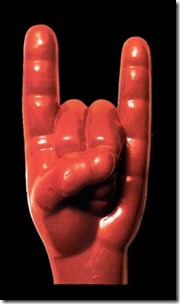Fare le Corna Posted by Serena on Oct 26, 2011 in Culture
Watching a live concert of our favourite Italian heavy metal band, Lacuna Coil, I was struck by the fact that the audience were all facendo le corna (making the horns), a common hand gesture here in Italy, especially in Napoli. I did a bit of research and discovered that the gesture was made popular in Heavy Metal culture by Ronnie James Dio during his time with the band Black Sabbath.
According to R.J. Dio “It was a symbol that I thought was reflective of what that band was supposed to be all about. It’s an Italian thing I got from my Grandmother called the "Malocchio". It’s to ward off the Evil Eye or to give the Evil Eye, depending on which way you do it. It’s just a symbol but it had magical incantations and attitudes to it and I felt it worked very well with Sabbath. So I became very noted for it and then everybody else started to pick up on it and away it went.”
In fact le corna (the horns) has far more ancient origins. In ancient Greek mythology the Minotaur, conceived from the extra marital relationship of Parsifae, Regina di Creta (Parsifal, Queen of Crete) with il Toro di Creta (the Cretan Bull), had the body of a man and the head of a bull. The population consequently began to use the cornuta , which resembles a bull’s head and horns, as a insult towards Parsifae’s husband, king Minosse. Interestingly, in Napoli, a city founded by the Greeks (Neapolis) the people have traditionally used many gestures which show a close resemblance to those used by the ancient Greeks, as was demonstrated by the archaeologist Andrea de Jorio in 1832.
From these ancient origins come the use of le corna to symbolize a husband who has been betrayed by his wife. In fact we use the expression essere cornuto to mean ‘to be betrayed by one’s spouse’ In Italy, the sign is frequently used as an insult, especially in situations such as partite di calcio (football matches) where it is used to insult the referee, and by Italian drivers to insult other motorists who they consider to have done something stupid or dangerous (yes, some of us Italians do drive sensibly!)
Sopra: Il calciatore Antonio Cassano fa le corna
The other main meaning of le corna gesture is il malocchio = the evil eye. In this version the fingers are usually pointed down towards the ground. Il malocchio is typically used when people say or do something which is considered unlucky, or when a portentous event, such as a black cat crossing one’s path, occurs. A famous example of the malocchio being used by a prominent public figure took place in 1975 when the President of the Italian Republic at that time, Giovanni Leone, shocked the whole country. Whilst visiting patients in hospital during an outbreak of cholera, Leone, a native of Napoli, shook their hands while making le corna with his other hand behind his back. The gesture, which he presumably used to keep himself safe from infection, was seen as being very offensive to the patients. This example demonstrates the deeply rooted nature of scaramanzia (superstition) in Italian culture, especially in the south.
More recently, in February 2002, our ‘humorous’ prime minister Silvio Berlusconi performed le corna gesture behind the back of the Spanish foreign minister during an official photo-shoot at a summit meeting of the EU. When later questioned about the incident, he replied "I was only joking”. Yes, our Silvio is a great comedian, ho ho ho!

Build vocabulary, practice pronunciation, and more with Transparent Language Online. Available anytime, anywhere, on any device.








Comments:
Lorraine Rignall:
I have not been able to share this post, because the forwarding information form will not scroll down far enough. Can this be rectified ?
Transparent Language:
@Lorraine Rignall Lorraine,
Are you still having this issue? If so, please provide more details about what’s wrong, and we’ll try to work through it with you. Thanks for reading.